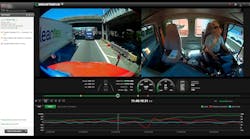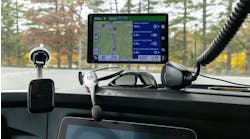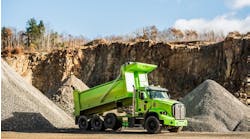More than one in three long-haul truck driver has been in a serious truck crash in their career. While crash deaths of occupants of large trucks held at about 5,000 between 2018 and 2019, non-commercial traffic deaths dropped 2% over the same period despite a 1% increase in vehicle miles traveled, according to the National Highway Traffic Safety Administration.
Don Osterberg, a former senior VP of safety, security and driver training at Schneider National, who now serves on SmartDrive's Board of Advisors, said the first response from people in the trucking industry is that “the problem is the four-wheelers” when it comes to highway safety. But the latest numbers show non-commercial drivers are getting safer.
Osterberg led a Truckload Carriers Association and SmartDrive webinar on Nov. 17 about how to maximize value from fleet safety programs. He stressed the “moral imperative that we have as transportation professionals to operate safely.” But also, Osterberg talked about how safety technologies can create financial gains for fleets of all sizes. “For those who creatively procrastinate with the notion that the next generation of safety technology will be better — of course, they’ll be better,” he said. “But the ones today are good enough and a good investment to make.”
The trucking industry needs to strive to be safer, Osterberg said. “We can't accept the negative trend line that we've seen in trucking crashes, injuries and fatalities,” he said. “So first, create a strong safety culture that's critically important for the efficacy of any of the technology solutions that you invest in.”
Osterberg and Jeremy Byrd, a SmartDrive regional sales manager, laid out six reasons to invest in better fleet video technology:
1. Reduce insurance claims and costs
Commercial trucking insurance premiums are on the rise and even safe fleets aren’t immune to this, Osterberg noted. A big reason is that nuclear verdicts are on the rise (the median payout is $1.7 million over the past decade — but that number is on the rise). Fleets are also relying on more drivers with less experience as a driver shortage continues to impact the industry. Deteriorating infrastructure across the country along with more in-cab distractions are contributing to the perceived risk. All of this is leading the providers who aren’t exiting the trucking industry to be ultra-selective about which carriers they will insure, he explained.
According to SmartDrive data, video-based safety systems can reduce insurance claims and costs by:
Providing video evidence and coaching tools, which are proven to reduce collisions
Providing data and measurable KPIs that show a reduction in risk
Exonerating drivers at the scene when drivers are not at fault
Showing your fleet is actively supporting loss control through investing in key safety technology
Being the backbone of your fleet’s continuous safety action plan and fit-for-duty program.
2. Improve driver satisfaction and retention
Drivers are leaving jobs now as freight demand is on the rise. Osterberg said the industry is not attracting enough new drivers to stem this loss. The American Trucking Associations estimates the driver shortage could top 100,000 positions in the next five years. Adding to the uncertainty is that more fleets are working to lure drivers by offering high driver sign-on bonuses.
SmartDrive contends that video-based safety systems, like the platform it offers, can improve driver satisfaction and retention by:
Focusing on drivers: encourage, reward and protect
Focusing on retaining drivers — as hiring new drivers is costly and time-consuming
Providing tools for data-driven reward programs based on safe driving
Showing commitment to safety through lower CSA scores
3. Improve workers comp claims
The trucking industry consistently ranks among the top five occupations with the most workplace injuries, according to Byrd. He said the potential for injury is significant for truck drivers because of all the on-the-job risks.
In trucking, most workers’ compensation claims come from injuries sustained during loading, unloading, slips, trips, falls, strains from entering and exiting the vehicle, repetitive body movements over long periods of time, falls from loading docks, handling heavy equipment and materials, and collisions, Byrd described. He noted that 27% of claims are attributed to slips, trips and falls while 17% come from collisions.
Video systems inside and outside trucks can help improve workers’ comp claims, Byrd said:
Reducing collisions through coaching risky driver behavior
Providing video evidence and coaching opportunities to help drivers remember to follow the proper scope of work
Capture event in and around the vehicle through extended recording so there’s visual documentation when there is a claim
Can also provide support to healing, as doctors can better understand the injury when they see how it occured.
4. Reduce fuel and maintenance costs
Fuel and maintenance costs are the second most costly aspect of running a fleet — behind the driver salaries. Even a small gain in miles per gallon can lead to big fleet savings, Byrd said.
Video-based safety systems, he said, can reduce fuel costs by:
Encouraging smooth driving
Increasing following distance and reducing speed helps reduce wear and tear on tires, brakes and reduces the need for windshield replacements
5. Improve customer service
With fierce competition in the freight space, it’s important for carriers to differentiate, Osterberg said. Customers and the public are more likely these days to report unsafe driving by fleets. Without recordings, some deliveries as be marked as missed. Low CSA scores can reflect badly on customers, encouraging them to go with fleets with better safety scores, he said.
Osterberg shared some ways that systems such as SmartDrive have shown to improve customer service:
Using manual triggers to record deliveries — or to prove why deliveries couldn’t be made
Utilizing extended recordings allows fleets to pull video based on time and location, which provides visual evidence to support or rebuke customer call-ins
Improving risky driver behavior, a major determining factor in CSA scores
6. Deter theft and ensure cargo securement
According to SensiGuard, there was a 17% increase in cargo thefts in the U.S. in 2019. The average loss was valued at $188,000. Some larger carries have had at least one full truckload stolen per week, Byrd said. He added that thieves are “shopping cargo” by breaking trailer seals to check out what’s in the truck, which even if they don’t steal it could contaminate the contents. Cargo is also being stolen, he added, because it wasn’t properly secured.
Video, Byrd said, can help deter cargo theft and ensure it is properly secured by:
Catching thieves in the act
Using camera placement and extended recordings to ensure work is done properly by drivers




